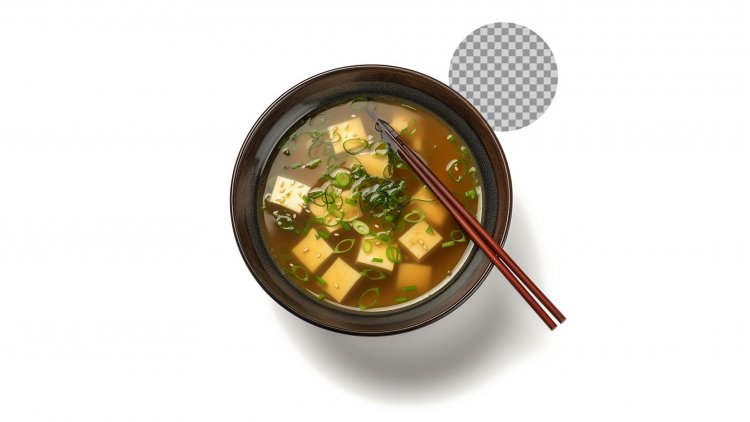Miso Magic: A Journey Through Classic Japanese Soup with Tofu, Seaweed, and Scallions
Miso soup is the quintessential Japanese comfort food that has captured hearts around the globe. Its rich umami flavor and nourishing ingredients make it a perfect addition to any meal, whether you’re looking to start your day with something light or seeking a warming bowl of goodness for dinner. This recipe will guide you through creating a bowl of miso soup that’s both delicious and deeply satisfying.

The Secrets of Miso Soup
Miso soup is a staple in Japanese cuisine, known for its simplicity and depth of flavor. At its core, the soup consists of a miso paste base mixed with dashi (a type of broth), with added ingredients like tofu, seaweed, and scallions. The beauty of miso soup lies in its versatility—you can customize it to your liking while maintaining its traditional essence.
Ingredients You'll Need:
- Miso Paste: The star of the show, miso paste is fermented soybean paste that adds a savory depth to the soup. You can choose between white, red, or mixed miso paste, each offering a unique flavor profile. White miso is milder and sweeter, while red miso has a stronger, more robust flavor.
- Dashi: This is the Japanese broth that forms the base of the soup. Traditionally, dashi is made from kombu (dried kelp) and katsuobushi (dried bonito flakes), but for convenience, you can use instant dashi powder.
- Silken Tofu: Adding a soft and delicate texture to the soup, silken tofu absorbs the flavors of the broth while remaining tender.
- Seaweed: Wakame is the most commonly used seaweed in miso soup. It rehydrates quickly and adds a subtle oceanic flavor to the dish.
- Scallions: Fresh scallions bring a burst of freshness and a hint of sharpness, balancing out the umami-rich broth.
- Optional Garnishes: You can also include additional ingredients like mushrooms, spinach, or even a dash of sesame oil for extra flavor.
Preparation Steps:
1. Prepare the Dashi
Start by preparing the dashi if you’re not using instant dashi powder. For traditional dashi:
- Kombu: Wipe a piece of kombu with a damp cloth to remove any dirt. Place it in a pot with 4 cups of cold water. Let it soak for about 30 minutes.
- Heat: After soaking, slowly bring the water to a simmer over medium heat. Just before it reaches a boil, remove the kombu.
- Bonito Flakes: Add a handful of katsuobushi (bonito flakes) to the pot. Allow it to simmer for about 5 minutes. Strain the liquid through a fine sieve or cheesecloth to remove the bonito flakes. Your dashi is now ready!
2. Incorporate the Miso Paste
- Heat the Dashi: Return the dashi to the stove and heat it over medium-low heat.
- Mix Miso Paste: Take a ladle of hot dashi and mix it with the miso paste in a small bowl until smooth. This helps to dissolve the miso evenly into the soup.
- Combine: Stir the miso mixture back into the pot of dashi. Avoid boiling the soup after adding the miso, as it can affect the flavor and texture of the paste.
3. Add Tofu and Seaweed
- Tofu: Cut the silken tofu into bite-sized cubes. Gently add it to the soup and let it warm through for about 2-3 minutes. Be careful not to stir too vigorously, as silken tofu is delicate and can break apart easily.
- Seaweed: Add a handful of dried wakame to the pot. It will rehydrate and expand within minutes. Let it cook for another 2 minutes.
4. Finish with Scallions
- Scallions: Slice the scallions thinly and add them to the soup just before serving. They will provide a fresh, crisp flavor that complements the umami-rich broth.
Serving Suggestions
Miso soup is traditionally served as a side dish, often accompanying a Japanese meal with rice and other dishes. It can also be enjoyed as a light lunch or a starter. Pair it with a bowl of steamed rice and perhaps some pickled vegetables for a complete meal.
Pro Tips:
- Customizing Flavor: Feel free to experiment with different miso pastes and additional ingredients like mushrooms or spinach to tailor the soup to your tastes.
- Texture Matters: For a more robust soup, you can add ingredients like sliced mushrooms or bok choy. Cook them in the dashi before adding the miso paste for enhanced flavors.
- Storage: Miso soup is best enjoyed fresh, but you can store leftovers in the refrigerator for up to 2 days. Reheat gently over low heat to avoid compromising the texture of the tofu and the flavor of the miso.
In summary, miso soup is a delightful dish that embodies the essence of Japanese culinary tradition with its umami-rich flavors and wholesome ingredients. Whether you’re enjoying it as a daily staple or as a special treat, this recipe offers a perfect balance of taste and nutrition. By mastering the basics of dashi and miso paste, you open the door to a world of delicious variations and comforting meals.
Disclaimer: The recipes shared on this blog are intended for informational and entertainment purposes only. We do our best to ensure accuracy, but ingredient and preparation variations can alter results. Please use caution and consult a medical professional if you have dietary restrictions or health concerns. The blog and its authors are not liable for any adverse effects or consequences resulting from the use of the recipes provided. Always prioritize your health and safety when cooking.
What's Your Reaction?





















